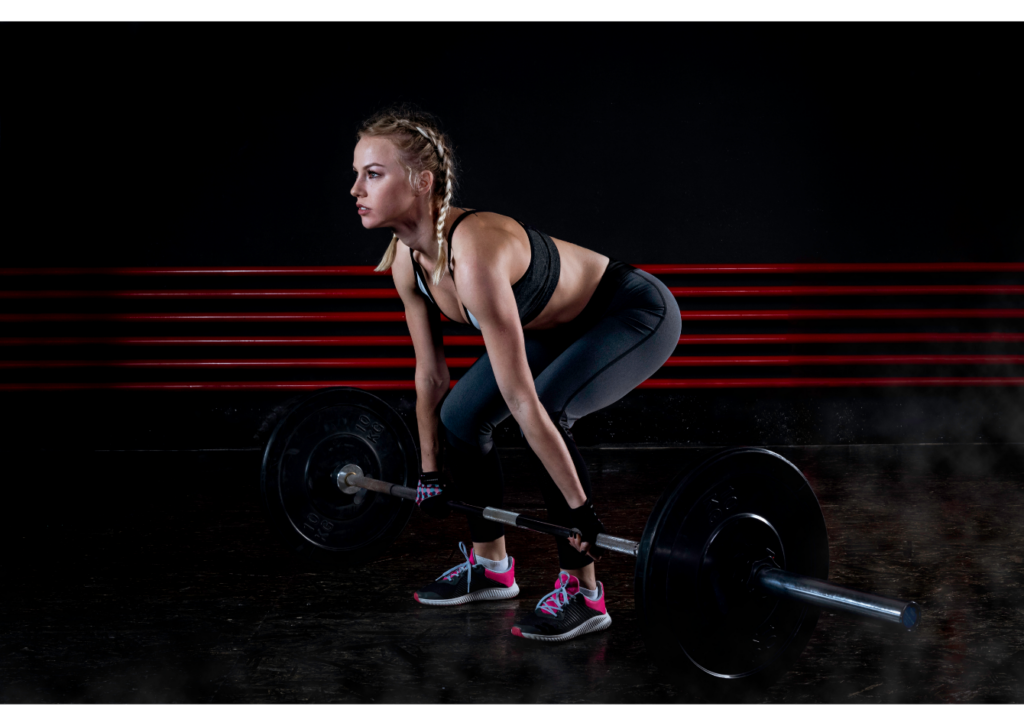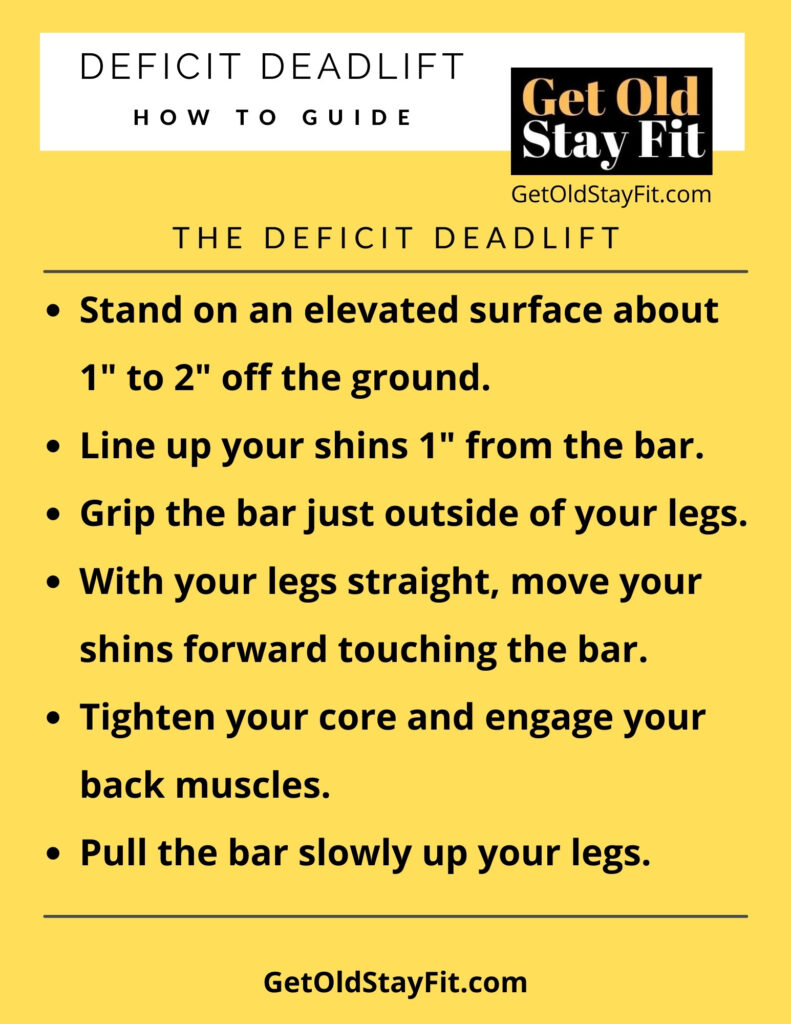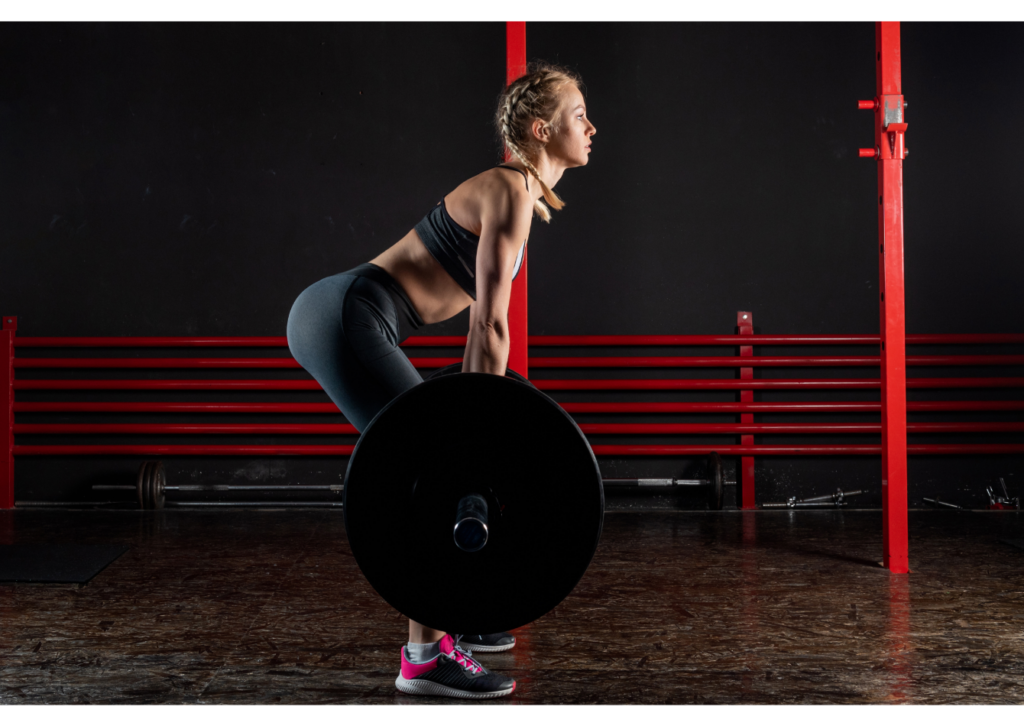The deficit deadlift is performed off an elevated surface. Its purpose is to limit the standard deadlift starting mechanics, and in the process, target those very same muscles for more explosive strength.
Have you hit the strength-gain wall in your deadlift? Are you looking for some variety in the gym, tired of the same old moves?
How about more explosive power on the court, or just better overall fitness? I have a new move for you; it’s called the deficit deadlift.
The Deadlift with a Twist
The deadlift is a popular and effective exercise among experienced weightlifters and strength training beginners.
Walk into any gym in America, and you will see people grunting and straining to do a deadlift. They lift a bar loaded with heavy weights, or maybe not so heavy, from the floor to their hips.
And then the bar is released back to the ground. Weightlifting is not just about using the heaviest weights possible.
A proper deadlift technique, along with variations to strengthen the low back and lats will provide an extra boost to your training program.
There are numerous deadlift benefits, including stronger leg muscles, core muscles, and especially large back muscles.

But, a straight deadlift is not always the best exercise for everyone. There may be ways to modify the exercise to get more bang for your workout buck.
How to Deficit Deadlift
One of the modifications that is gaining popularity is the deficit deadlift.
Now you’re probably wondering, what exactly is a deficit exercise? Well, the good news is it’s far easier and more intuitive than the name may suggest.
In a traditional deadlift, you stand on the floor so the bar and your feet are basically at an identical height. However, in a deficit deadlift, you stand on a small raised platform.
This means that the height of the bar will seem lower than usual. You will be reaching down to grab the bar and then bringing it to hip height.
Doing this exercise requires you to demonstrate a greater range of motion.
- Stand on an elevated and sturdy surface about 1” to 2” off the ground
- Line up your shins about an inch from the barbell
- Grip the bar just outside your legs
- With your legs straight, move your shins forward touching the bar
- Tighten your core and engage your back muscles
- Pull the bar slowly up your legs
Deficit Deadlift Platform
Before you start to fret about the platform, you’ll be relieved to learn that the deficit height doesn’t need to be much.
Often, the height is only 2 to 4 inches above the ground or flat surface. The actual height is not what’s important.
What is important is your body and your key muscle groups are working harder to take the bar through its full range of motion.
From an elevated platform, feet hip-width apart, the start of each rep of the deficit deadlift position should be similar to the traditional deadlift.

You may not lift the same heavy-weight plate, but breaking weight records is not the point of this move.
What’s more important with the deficit deadlift is using lighter weights, a larger range of motion, and starting in a solid deficit position.
With the deficit deadlift, knee and hip flexion is increased, and the erector spinae, hamstrings, and glutes are strengthened.
A good rule of thumb is to use 15 – 20% less weight than a typical deadlift. You can even use one of your 45-pound plates for a small platform to stand on if needed.
Like any compound move, good position and technique is essential for experienced lifters and beginners. And always be sure to warm up properly before you begin.
Benefits of Deficit Deadlifts
Below, we have outlined some of the most important benefits of this twist on the traditional deadlift, which already generates a lot of deadlift benefits.

Benefits of Deficit Deadlifts
Below, we have outlined some of the most important benefits of this twist on the traditional deadlift, which already generates a lot of deadlift benefits.
#1 Gain Explosive Power with Deficit Deadlifts
The first benefit of the deficit deadlift is that it teaches your body to develop explosive power. Because you are starting in an awkward and somewhat unbalanced position, your body needs to work harder to get the same results.
In addition, it is not just about the explosiveness that is required. Some of the benefits are far simpler to understand from a physics perspective. If you are lifting a bar an additional 6-9 inches, for example, it will likely take you longer.
This means that your muscles are contracting and working for a longer period of time, and all else equal, more work will build stronger muscles.
In many ways, this deficit mimics what would happen if you added more bumper plates to a traditional deadlift.
Luckily, explosive power is not the only benefit that you will see from adding a deficit deadlift into your workout regimen.
#2 Deficit Deadlift Improves Flexibility
Even though we usually think about this exercise as a move of brute strength and power, doing it correctly with the proper form also requires flexibility.
Because of where the bar is located in a deficit deadlift, you need to bend deeper into your initial crouch.
This will enhance your hip mobility, and flexibility and give an increased range of motion, especially across the hip flexors, which tend to be stiff.
Increased Range of Motion
This is especially true for men and even more so for men who are weightlifters. Numerous benefits begin to compound over the long run with an increased ROM.
This new position is excellent for flexibility, but it is crucial that you carefully check your form when doing a deficit deadlift.
The important thing is to have a flat back and a neutral spine. Many people will curl their back to compensate for a lack of flexibility, and this can lead to unfortunate injuries.
To ensure this does not happen to you, start with a lighter weight than you usually use on a conventional deadlift when trying out deficit deadlifts.
Once you have gained familiarity with the exercise, you can slowly add a bumper plate or two and increase the weight.
#3 Deficit Deadlift Improves Performance and Functional Strength
Another benefit of the deficit deadlift is the skills and power you learn from doing this exercise can translate over to a better regular deadlift.
Not surprisingly, you will likely find that you can lift more weight more easily when you move back to doing a regular deadlift. It can also improve your functional strength, not only in sports but in everyday life.
#4 Deficit Deadlift Works More Muscle Groups
Ideally, one of the most important deadlift benefits is that it exercises a wide range of muscle groups. You’ll benefit from working your legs to your core, the posterior chain muscles, shoulder blades, and up to your arms.
But, often, people do not use the best form possible to do a deadlift. They power through it, often overutilizing their core muscles and arms. This can lead to injuries, but it can also lead to weak leg muscles.
With the more challenging starting position of the barbell deficit deadlift, it is harder for people to power through. Instead, the lifter will need to engage their legs, especially their glutes and hamstrings.
Even though this can be uncomfortable, it is also a good thing! Strong glutes and hamstrings help you in a wide range of activities.
Strengthen the Weakest Link
Another significant benefit of the deficit deadlift is that it strengthens the weakest link in the muscle chain. The additional range of motion tends to identify the weak point and strengthens it over time.
If you’re struggling with the initial pull off the floor in the traditional deadlift, the deficit deadlift will target that exact point.
The deficit deadlift also assists lifters with long arms who can’t get a full range of motion with a traditional deadlift.

Different Types of Deadlifts
It is important to remember that regular deadlifts and deficit deadlifts are not the only types of deadlifts out there.
Several deadlift variation moves or modifications can be introduced once you have the basic deadlift motion perfected.
Embracing these different types of exercises is good on multiple counts.
First, it gives variety to your exercise program. People can quickly get bored with their exercise routine, and boredom can cause people to throw in the proverbial towel.
If we give people greater variety through exercises like the deficit deadlift, we can help fight boredom.
However, this is not the only benefit. By slightly modifying an exercise, we can ensure that different parts of our body and muscle groups get more or less work.
As you might imagine, this is good for building overall body balance.
Deadlift Modifications
In addition to deficit pulls, what are some other modifications you could try?
Don’t get stuck on the bench press five days a week, mix in a few deadlift variations to keep things fresh in the gym.
Sumo Deadlift
Another potentially good maneuver is the sumo deadlift. This modification is great for a person struggling with lower back pain or other muscle twinges.
In a sumo deadlift or the sumo puller, the lifter will walk their feet out to a wider position. Their hands will remain shoulder width apart with an overhand grip, so on the inside of their legs.
Many people find it dramatically easier to lift the bar from this sumo stance position, even a significantly heavier bar.
Trap Bar Deadlift
The trap bar deadlift is another deadlift modification that may take significant stress off of your lower back.
However, this modification may be more challenging because not all gyms have a hex bar that is needed to complete these exercises.
But, if your gym does have this piece of equipment, it can be a great exercise to try.
Rack Pulls Vs Deadlift
A rack pull is the opposite of a conventional deficit deadlift. The barbell is elevated off the floor at the starting position, reducing the range of motion and load on the lower back and hamstrings.
The benefits of rack pulls vs. deadlifts are the ability to work around strains and pain in your lower body. Another benefit to rack pulls vs deadlifts is you can lift heavier loads, which is beneficial for building upper back muscles.
The smaller deficit, the greater weight you’ll be able to lift.
Snatch Grip Deficit Deadlift
Use the snatch grip to take your deficit deadlift to the next level. In this lift, your hands are positioned on the bar to the outside of your knees.
With this grip, you will be at a lower starting position, and your range of motion will increase from the standard deficit deadlift. The snatch grip deadlift is a great way to strengthen your upper back and quads.
Single-leg Romanian Deadlift
If you’re someone who is looking for an additional challenge, you may want to consider adding a single-leg Romanian deadlift to your exercise routine.
This advanced variation exercise is challenging for many people because it not only requires strength and power but also needs a great sense of balance. Unfortunately, many people struggle with balance.
Another thing to remember about this type of deadlift is that it could also be challenging if a person has knee problems or pain in the legs. In this exercise, you will be balanced on one leg slightly bent at the knee.
The other leg will be extended out behind you. Given the challenging leg position, people doing this exercise will be lifting a lower weight than you would in a traditional deadlift.
Make sure that once you have completed the training with one leg being your base leg, you switch sides.
Symmetry is important. If you find yourself struggling with your balance, make sure to focus on your breathing, taking regular and controlled inhalations and exhalations.
And, also, take your time. You do not have to perfect this exercise in just one day.
Try the Deficit Deadlift
Deadlifts are a popular compound exercise with many benefits for millions of Americans, particularly weightlifters and others looking for a way to radically improve their core strength.
In addition to boosting core strength, there are many other deadlift benefits, such as firing up the glutes and hamstrings. The maneuver can lead to increased hypertrophy and growing muscle.
It’s also great for people who might get bored doing the same exercise week after week and are looking for other types of deadlifts.
Active bodybuilding, powerlifting, and Crossfit enthusiasts might find themselves hitting a plateau in their weight training, unable to improve over a certain period of time.
Bust Through Strength Plateaus
The Deficit deadlift is perfect for busting through your strength plateaus and pushing you to new lockout strength.
One of the best deadlift modifications is the deficit deadlift, which boosts power, explosiveness, and flexibility.
With time, practice, and not too much weight initially, as well as initial guidance from a professional trainer, a deficit deadlift can be an essential way to build strength and a fun addition to your exercise program.
READ more about weight training for longevity and overall health –
What Muscles Do Pull Ups Work? A Guide for Beginners
Master the Close Grip Bench Press
Additional Resources –
The Deadlift and Its Application to Overall Performance – National Strength and Conditioning Association
Improving the Deadlift – Strength and Conditioning Journal
Exercise Technique: Deficit Deadlift – ResearchGate.net
